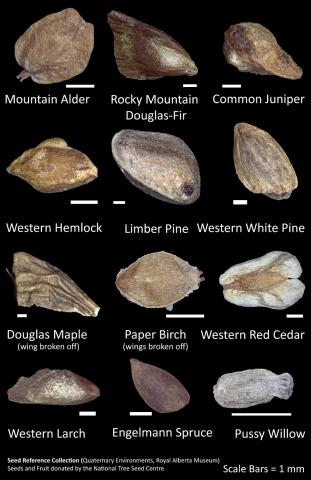Learn about Alberta's forests through seeds!
May 3, 2022
By Diana Tirlea, Assistant Curator, Quaternary Environments
How much do you know about seeds? Seeds are small but essential pieces of forest ecosystems. Read on to learn more about seeds with us for Alberta Forest Week!

Forests are found in much of Alberta. Our forests range from the dense conifer-dominated boreal forests to the parkland forests with poplars, birches and conifers, and up high on mountain slopes as stunted krummholz.
All of these trees produce seeds (or seeds inside the fruit), which is one way they produce new seedlings to maintain the health and diversity of Alberta's forests.
Many of these seeds and fruits have special features designed to help them disperse in hopes of landing in the best location to germinate and start growing. For example, they may have a thin "wing" along the margin, helping them be dispersed by wind. Or they are lightweight and buoyant, allowing them to move on water. Trees must produce lots of seeds each year as many seeds never germinate. Instead, those extra seeds decay, get eaten or even end up in lake sediment, peatlands, ice, or dung, where they are preserved for millennia.
In the Quaternary Environments program at the museum, we sample places like lake bottoms (cores) and ice (glaciers, ice patches), looking for these preserved seeds and other plant remains. This type of research helps scientists understand how the past forests in Alberta changed over time due to climate change, forest fires, or even insect infestations.
To identify the seeds we find, we need to have an extensive seed reference collection that we can use to compare the plant remains we find. We build these reference collections through field collection and working with other institutions who donate material to round out our collection.
We recently acquired seeds and fruits from different tree and shrub species throughout Canada from the National Tree Seed Centre in Fredericton, New Brunswick. Steven Friedenthal, a volunteer at the museum, has been diligently cataloguing and imaging these specimens. Soon they will be added to our Seed Reference Collection. One of these specimens may be the next to help identify a 10,000 years old recovered seed!
Chances are high that you have had an opportunity to enjoy outdoor time in some of Alberta's forested areas. Learn more about these crucial areas of nature in Alberta by exploring the activities and resources on the Alberta Forest Week (May 1-7) page as well as the RAM Quaternary Environments page and the National Tree Seed Centre.